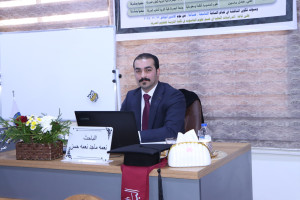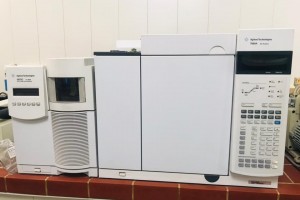
The College of Education for Pure Sciences at the University of Basra discussed a doctoral dissertation entitled (A blood, biochemical and genetic study in patients with beta thalassemia in Maysan Governorate)
The thesis presented by the researcher (Abbas Kazem Jahil) included
The first part: included the study of some blood parameters such as (RBC, WBC, HGB, MCV, PLT) and some biochemical parameters, including functional enzymes of the liver (ALT, ALP, AST., TBS, TP) and some functional parameters of the kidneys (Urea, Creatinine). A study of the levels of inorganic calcium and phosphorous and the percentage of ferritin (iron stock) A comprehensive demographic study of housing, sex, blood groups and age, and a study of the correlation between increased levels of ferritin and the parameters under study. This was followed by group (O) with 29%, then group (A) with 26%, then group (AB) with 4%.
The study showed that the percentage of the effect of the sex factor on males is similar and equal to the percentage of its effect on females for patients compared to healthy subjects. 28%) for ages (≥10), then these percentages begin to decrease with age until they reach (24%) for ages between (20-29) years, and (12%) for ages (≥30). The results of the study recorded the superiority of the city over the countryside in The percentage of infection, as the infection rate in the city was (65%), while it was in the countryside (35%). Also, the results of the current study recorded a highly significant relationship (P<0.000) for all blood parameters with a decrease in (HGB) levels (RBC), ( MCV) of patients and a higher level of white blood cells (WBC) and platelets (PLT) compared to control. The current study recorded a highly significant relationship (P<0.000) and elevated levels of all liver enzymes (ALP), (ALT), (AST), (TSB), and (TP) compared to the control group. The current study showed a highly significant increase in urea levels and higher creatine levels compared to control. The results of the linear regression analysis showed that there is a correlation between ferritin and blood parameters, where the relationship was significant with (RBC, HGB, (MCV) and non-significant with WBC, PLT), while there was a correlation between levels of ferritin and liver and kidney enzymes, where the relationship was significant and positive with each Of (ALP), (AST) (TSB), and positive non-significant for each of (ALT) (TP), (Urea), (Creatinine).
The second part:.
The results of the statistical analysis of the HBB gene sequence analysis for the genetic segments selected in this study, which were 696 base pairs and 861 base pairs, respectively, indicated that there were 5 mutations distributed in different regions of the gene, three of which were on the first genetic segment at 205.C>T sites. And 294.T>C and 389.G>A and two on the second plot, which are 49.T>C and 624.C>A. The mutant (T) for the first mutation (205.C>T) 25% compared to 5%, and in the second mutation 294.T>C the allele (C) recorded 12% compared to 0%, in the third mutation 389.G>A The mutant allele (A) recorded 38% compared to 0%. In the fourth mutation, 49.T>C, only the mutant allele (C) recorded 32%, compared to 15. As for the fifth mutation, 624.C>A, only the mutant allele (A) was recorded. ) 32% compared to 15% for the patients group compared to the control group, respectively. The results did not notice any significant differences between the distribution of all these mutations between the patient group and the control group using the statistical analysis using the Chi-Square model, except for the third mutation (389.G>A), where the mutant allele (A) was significantly superior, as the P.value recorded a value of (0.02)* as The distribution of the mutant allele was 38% for the patients group compared to 0% for the control group, while the chi-square value was 7.5 when comparing the two groups.
49.T>C) and 624.C>A, respectively, recorded a clear superiority in its frequency in the group of thalassemia patients when compared to the group of healthy people, and for all mutations that we obtained in this study, the results of the statistical analysis using the Chi-square test indicated a high superiority Significant (0.001) for the frequency of the A allele of the mutation (389.G>A) in the patients group compared to the healthy group. The results of the statistical analysis did not show any significant differences between the mutation alleles (205.C>T), (294.T>C) and 624.C>A) when comparing between the patients group and the healthy group, as it showed only arithmetic differences between the frequencies of the alleles.
The results of the study showed the effect of mutations (205.C>T), (294.T>C), (389.G>A), (49.T>C) and (624.C>A) on a significant relationship with Each of ferritin, inorganic phosphorus, urea, ALT, AST, ALP and a non-significant relationship with each of creatinine and calcium.The genotypes and mutations discovered were distributed geographically to the center of Maysan Governorate and the districts and sub-districts of the governorate, so the largest percentage of infection was in the center of the governorate, then Al-Salam district, then Al-Musharah district, while The percentage of mutations was the same in each of the districts of Al-Majar, Al-Maimouna and Qalaat Saleh districts, and no results appeared in the rest of the regions.The results of the first region study (bp696) showed that the total number of haplotypes (Haplotype network) of the HBB gene is equal to 7 haplotypes. The results of the study for the second region (861bp) showed that the total number of haplotypes of the beta-clobin gene is equal to 10. The results of the study for the genotype of genetic mutations showed that the highest incidence was of the homozygous type, where the total percentage of homozygous was (78%) This percentage was distributed between
Among the genetic mutations are as follows, where the percentages were (16%, 17%, 17%, 13%, 15%) for mutations (.C>T 205), (294.T>C), (389.G>. A, (49.T>C) and 624.C>A), respectively. While the percentage of beta thalassemia was heterozygous, where the total percentage of heterozygous was (22%) and it was distributed among mutations as follows (4%, 3%, 3%, 7%, 5%) for mutations (.C > T (205), (294.T>C), (389.G>A, (49.T>C), and 624.C>A), respectively.
Thesis objectives
Evaluation of the prevalence of thalassemia in Missan Governorate
Studying the molecular aspects of beta thalassemia patients in Missan Governorate through the application of polymerase chain reaction (PCR) technology and genetic sequencing technology.
Studying the frequency and percentages of most of the diagnosed mutations, and this establishes an appropriate management protocol for thalassemia patients in Missan Governorate.
Building a database of types of mutations for thalassemia patients in Missan Governorate and detecting the most common mutations associated with thalassemia
Evaluation of the relationship between blood and biochemical parameters using effect results and the correlation between ferritin levels and blood and biochemical parameters of thalassemia patients.








